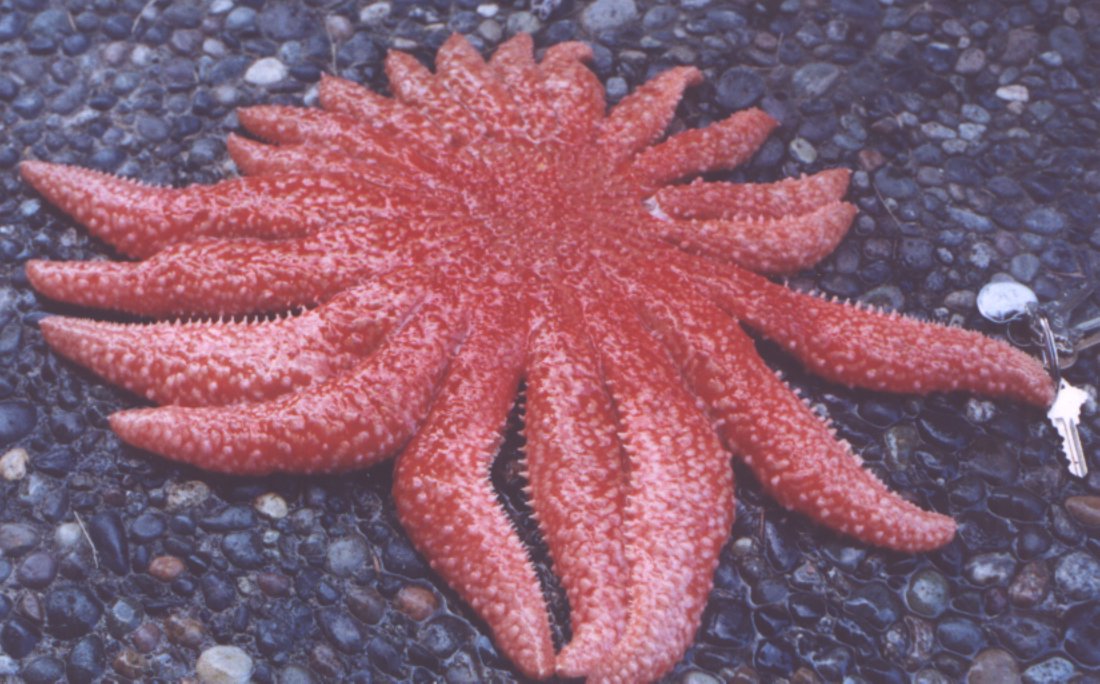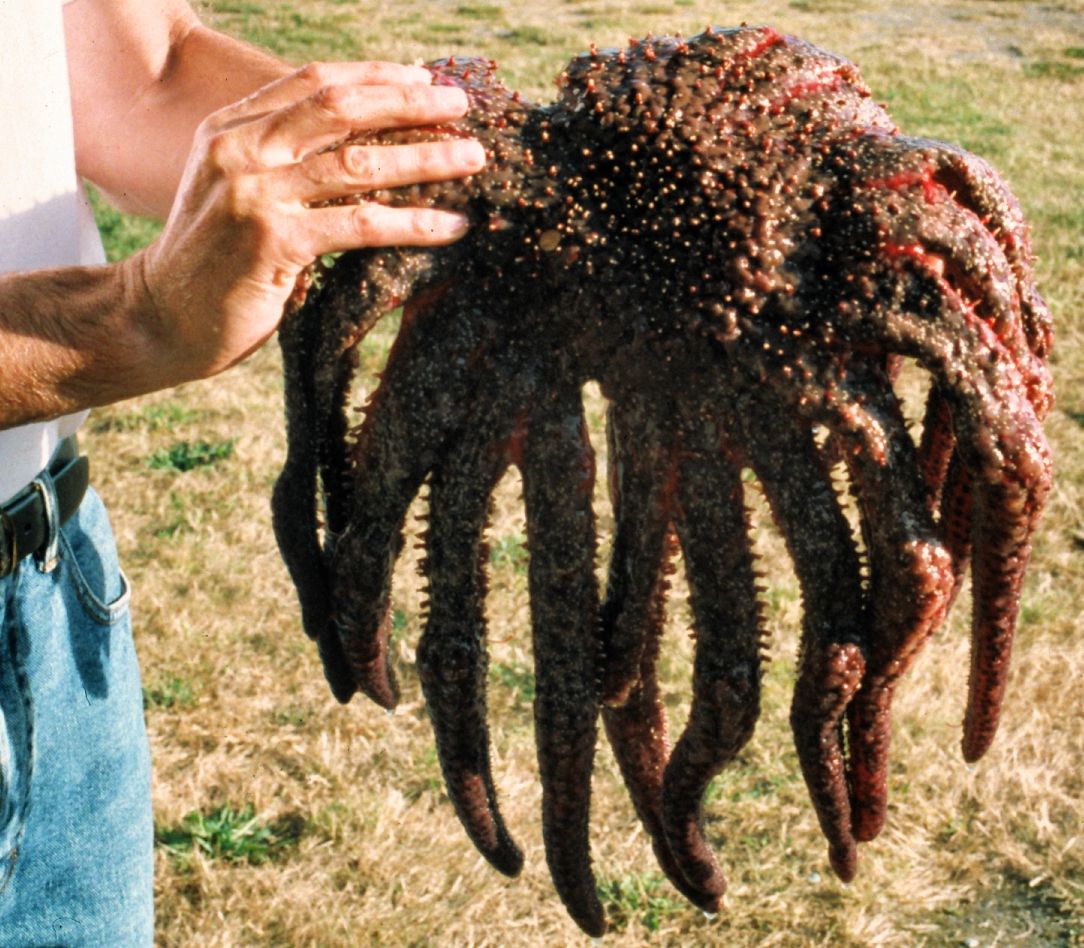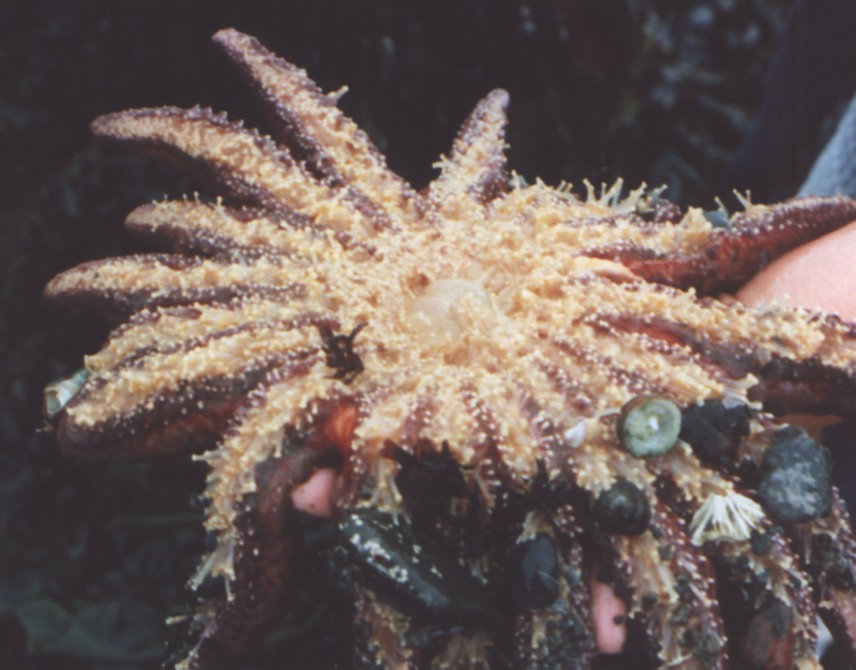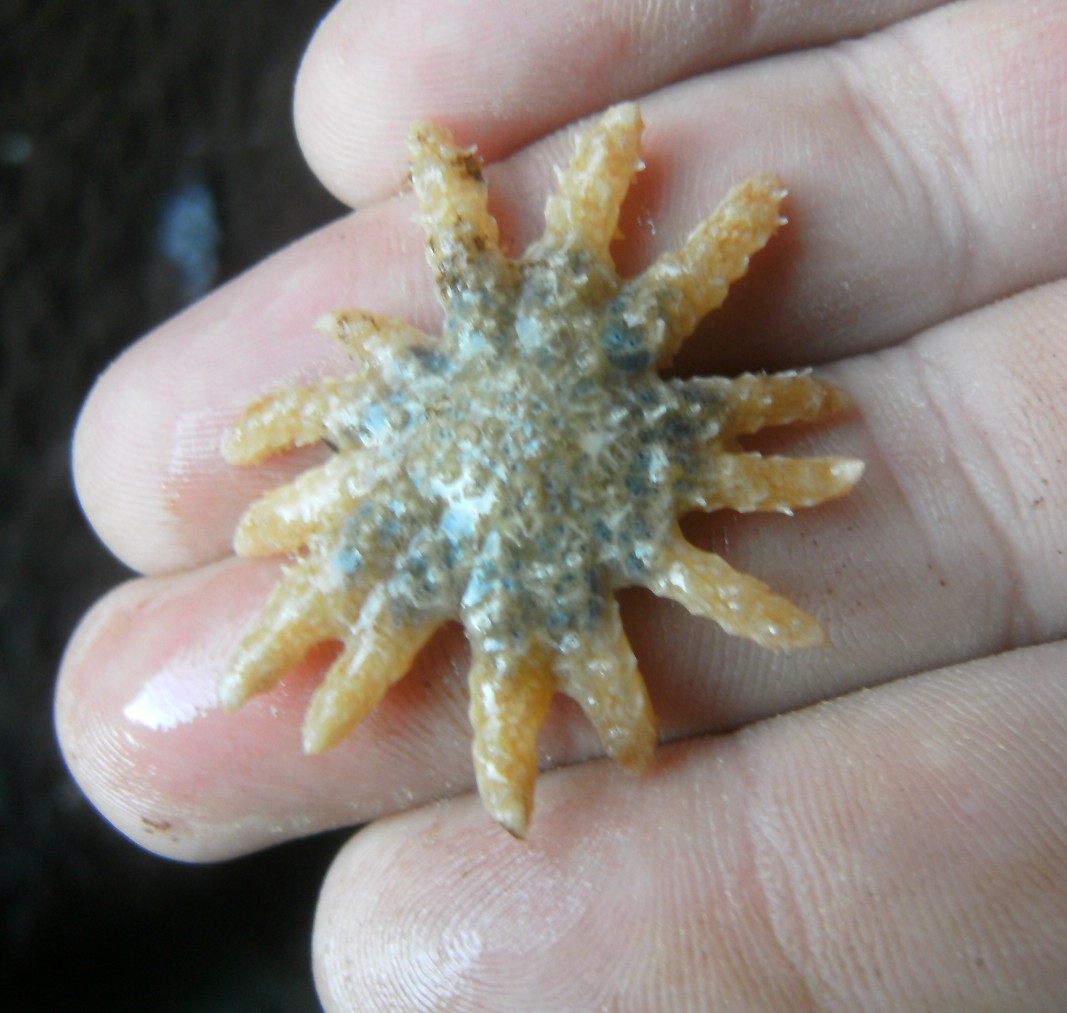Pycnopodia helianthoides (Brandt, 1835)Common name(s): Sunflower star, Many-legged sunflower, Twenty-rayed star |
|
| Synonyms: |  |
| Phylum Echinodermata
Class Asteroidea Order Forcipulatida Suborder Asteriadina Family Asteriidae |
|
| Pycnopodia helianthoides captured subtidally from Sares Head. | |
| (Photo by: Dave Cowles, July 2000) | |
How to Distinguish from Similar Species: This seastar is larger and has more rays than any other seastar in our area. Small individuals could be confused with Solaster dawsoni or Crossaster papposus, but both of those species have 16 or less rays, have no pedicellariae, and are not as markedly limp as Pycnopodia is.. S. dawsoni also does not have the prominent projecting spines, and C. papposus' spines are not extra prominent along the margins of the rays as they are in this species.
Geographical Range: Unalaska Island, Alaska to Baja California; uncommon south of Monterey Bay
Depth Range: Low intertidal to 435 m. Nearly always subtidal.
Habitat: Mostly subtidal, rocky, gravelly, or sandy bottoms.
Biology/Natural History: This species is a voracious subtidal predator, feeding on bivalves, snails, chitons, urchins, other asteroids, sea cucumbers, sand dollars, and crabs (in other words, just about anything it wants!). It will also scavenge dead animals. It may be the largest and fastest seastar in the world. It can move up to 3 meters per minute, and has been known to travel at least 3 km. It has over 15,000 tube feet. Tiny, newly metamorphosed juveniles of this species have only 5 rays but rays are added as the individual grows. Has very prominent spines and (crossed) pedicellariae, plus purple papulae. Loss of rays upon handling seems to be due to autotomy. In Puget Sound this species excavates butter clams (Saxidomus gigantea) by picking up sediment particles over the clam, passing them out to the ends of the rays, and dropping them. Often eat urchins such as Strongylocentrotus purpuratus, whose spines may pierce through from the stomach to the aboral surface. Can evert its stomach but more often swallows its prey whole. Predators include Alaska King crab and some large Cancer crabs. Individuals are agressive toward one another (and to almost any other seastar). Spawns March to July (some also in winter); has fertilizable eggs at least from December to June. May stand on the tips of their rays while spawning. Pelagic larvae metamorphose to benthic, 5-rayed juveniles at 9-10 weeks.
This species has a large, fleshy body with an only loosely articulated skeleton, and relies on fluid pressure to maintain its body form. It appears to rely more heavily on fluid uptake through the surface than on uptake through the madreporite. Its perivisceral fluid is more hyperosmotic than that of several other local species. This may aid in fluid uptake (Ferguson, 1994) and maintaining body form.
| Return to: | |||
| Main Page | Alphabetic Index | Systematic Index | Glossary |
References:
Dichotomous Keys:Flora and Fairbanks, 1966
Kozloff 1987, 1996
Smith and Carlton, 1975
General References:
Gotshall
and Laurent, 1979
Harbo,
1999
Kozloff,
1993
Morris
et al., 1980
Niesen,
1997
O'Clair
and O'Clair, 1998
Scientific Articles:
Brewer, Reid and Konar, Brenda, 2005. Chemosensory responses and foraging behavior of the seastar Pycnopodia helianthoides. Marine Biology 147(3): pp 789-795 (abstract): (Pycnopodia bypassed uninjured prey of the butter clam Saxidomus giganteus in favor of injured individuals; apparently due to chemical cues.)
Ferguson, John C., 1994. Madreporite inflow of seawater to maintain body fluids in five species of starfish. pp. 285-289 in Bruno David, Alain Guille, Jean-Pierre Feral, and Michel Roux (eds). Echinoderms through time. Balkema, Rotterdam.
Greer, D., 1961. Feeding behavior and morphology of the digestive system of the seastar Pycnopodia helianthoides. M.S. Thesis, University of Washington, Seattle, WA
Hotchkiss, Frederick C., 2000. On the number of rays in starfish. American Zoologist 40:3 pp. 340-354
Knott, K. Emily, and Gregory A. Wray, 2000. Controversy and consensus
in Asteroid systematics: new insights to Ordinal and Familial
relationships. American Zoologist 40:3 pp. 382-392
Mauzey, K.P., C. Birkeland, and P.K. Dayton, 1968. Feeding behavior of asteroids and escape responses of their prey in the Puget Sound region. Ecology 49: pp 603-619
Mladenova, P., S. Igdoura, S. Asotra, and R. Burke, 1989. Purification and partial characterization of an autotomy-promoting factor from the sea star Pycnopodia helianthoides. Biological Bulletin 176: pp. 169-175
Moitoza, D. and D. Phillips, 1979. Prey defense, predator preference, and nonrandom diet: The interactions between Pyconopdia helianthoides and two species of urchins. Marine Biology 53: pp 299-304
Nishizaki, Michael T. and Josef Daniel Ackerman,
2005. A secondary
chemical cue facilitates juvenile-adult postsettlement associations in
red sea urchins. Limnology and Oceanography 50(1): pp 354-362
(Adult
Strongylocentrotus
franciscanus urchins release a chemical signal which causes
young urchins
to aggregate underneath them when the adults detect the presence of Pycnopodia
helianthoides)
General Notes and Observations: Locations, abundances, unusual behaviors:
This was formerly a common species subtidally in the area around Rosario.
2014: This species is being especially hard-hit by seastar wasting disease. We have observed many individuals succumbing rapidly to the disease.
2015: For the first time in my memory, I have gone a whole summer without seeing a single live Pycnopodia helianthoides, either subtidally around Rosario or out on the open coast. They seem to have been thoroughly devastated by the wasting disease.
2019 summer: During the course of many dives from the marine station this summer, divers encountered individual Pycnopodia helianthoides on at least two occasions (one of them I encountered myself). Both of them were around 30 cm diameter, which is still small for a Pycnopodia but it is definitely growing up. Before the wasting disease the species was common here and even abundant in some places, so it is gratifying to see them gradually appearing again. They are primarily a subtidal species but occur occasionally in the very low intertidal zone. I have yet to encounter one intertidally since 2014 (although even when it was abundant it was primarily subtidal).
2020: This species was listed as critically endangered this year by the International Union for the Conservation of Nature (IUCN). This category is on the "red list" and implies that it may be only one step from extinction. The IUCN listing is here and a Nature Conservancy article on this listing can be found here.

The animal is so flaccid that if its body is held long in the air,
rays will break off and fall, as has happened to this specimen just
above
my hand. Photo by Dave Cowles, July 1997

Besides the large spines and pedicellariae on the aboral side, this
seastar has long tube feet on the oral side. Note that this
individual
has been recently feeding, as indicated by the partly everted stomach.
Photo by Dave Cowles at San Simeon, CA, April 1997
This seastar can move extremely rapidly for a seastar. Its presence elicits an escape reaction from many species such as the spiny scallop Chlamys hastata (click here for an .MPG movie), the sea cucumber Parastichopus californicus, and limpets.

June 2005: Brought in an individual from outer Rosario Bay
that
was 76 cm in diameter. Held by Dave Cowles and Greg Ryals.

This species is usually found subtidally but can sometimes be found
in the very low intertidal or in cave tidepools, as this one was.
Note the purple color.

This tiny individual was in the intertidal at Cape Flattery, WA. Photo by Dave Cowles, July 2010.
Authors and Editors of Page:
Dave Cowles (2005): Created original page